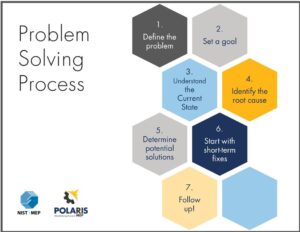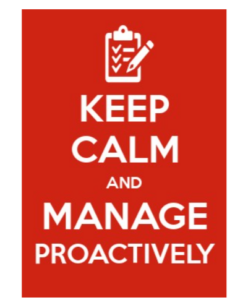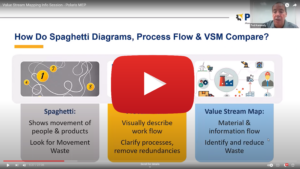By Sue Via, Senior Project Manager at TechSolve, part of the NIST Manufacturing Extension Partnership (MEP) National Network
Polaris MEP is the Rhode Island Center for the MEP National NetworkTM, whose mission it is to strengthen and empower small and medium-sized manufacturing companies in the United States.
 Research has shown that, during times of economic uncertainty, companies that find a balance between reducing the resources they need to survive and investing in key areas for growth will fare better. This is true for Rhode Island manufacturing companies and other manufacturers across the US.
Research has shown that, during times of economic uncertainty, companies that find a balance between reducing the resources they need to survive and investing in key areas for growth will fare better. This is true for Rhode Island manufacturing companies and other manufacturers across the US.
It’s a nuanced approach that involves playing offense and defense at the same time.
Many small and medium-sized manufacturers have been significantly impacted by the COVID-19 pandemic and find themselves with few apparent options. They have reduced their use of resources to the point that they feel there’s no time for anything beyond operations. When they do have time, it’s due to a decrease in business – and that means they don’t have money to invest.
As a result, they may become risk averse, hesitant to upgrade machinery or hire new people before more business returns.
Hunkering down to wait out economic uncertainty is typically not a path that leads to growth or positive change.
We recommend creating a lean management road map to help your company explore and exploit opportunities.
Creating a culture of continuous improvement
Get out of risk-adverse mode by dreating a company culture that encourages new ideas and being willing to consider better ways of doing things.

CASE STUDY: Polaris MEP helped Kennedy Incorporate write their own “success story” with Continuous Improvement training, coaching.
Continuous improvement starts with this mindset of openness but takes it further. Continuous improvement depends on a methodology whereby activities become routines that can be measured and reviewed.
A lean management road map can help your company become more proactive and resilient. The plan follows a typical lean journey using these five areas:
- Value stream mapping: Mapping all the steps required to bring a product or service to the customer.
- Standard work: Documenting the procedures used to make products in the most efficient way possible.
- Training strategy and methodology: Creating effective onboarding that helps new employees understand the rationale behind their work.
- Problem-solving process: Surfacing and addressing the root cause of a problem, as opposed to treating the symptoms.
- “Just do it” attitude: Adopting a proactive approach to work that emphasizes accountability.
We’ll explore how each of these areas is considered in a lean management road map below.
Value stream mapping
This process helps everyone see the flow of information and materials throughout the value stream. It helps a company determine what it wants to be, clarify the current state of its operations, and put together a three or five-year plan. It’s about vision, not details.
Clarifying the current state of operations helps on several fronts, primarily by identifying competencies and gaps.
Once a company has articulated its goals – for example, to increase production by X, or market share by Y, or enter a new product or customer market – it can set up a yearly project plan for how it will close gaps and invest in opportunities to reach those goals.
The value stream mapping process includes a case study that identifies and evaluates the current state of:
- Resources in the value stream
- Capacity
- Value-added vs. nonvalue-added activities
- Constraints
As with all things on a lean journey, there will be metrics for gauging how well you are implementing the plan, overcoming obstacles and achieving progress.
Standard work
![]() Many manufacturers have documented procedures detailing the worker actions, inventory, equipment and facility resources necessary to make a product. However, many lack methods for updating these standards. They would be wise to review their standard work on a regular schedule to keep it current.
Many manufacturers have documented procedures detailing the worker actions, inventory, equipment and facility resources necessary to make a product. However, many lack methods for updating these standards. They would be wise to review their standard work on a regular schedule to keep it current.
Documenting how things should be done not only drives consistency and quality, but it also provides a baseline for measurement. How else would you know if you are getting better at something or increasing potential capacity?
Are you measuring production by the hour or by cycle time? Are you becoming more efficient? How does the introduction of a new material or process impact production? Having a process for documenting and updating standard work – and a feedback system – will answer these questions.
Training strategy and methodology
The state of a company’s workforce development capabilities is often a snapshot of its work culture. Onboarding is not just filling out human resources documents. It’s also about teaching safety and quality standards. The onboarding process sets the stage for the first job assignment.

If key areas of onboarding and training follow strong adult learning protocols, companies tend to have fewer retention issues. Best practices say adults learn new tasks the most quickly and accurately when they are first shown what to do, then shown again and told what to do, and finally shown and told why it is done that way and how it fits into the whole operation.
This approach helps a new employee understand and retain the importance of the job steps.
Here are a few tips for creating a successful job onboarding and training environment as part of a lean management road map:
- Begin with a mentored, certified trainer to ensure consistency and competency.
- Provide audited training. Anyone performing the job functions is capable of basic problem-solving, but someone should be close by to help as needed and to frequently check in on new employees.
- Identify workers who can train others. Workers with expert-level competency understand the process and how their roles fit into the bigger picture and can explain it to others.
Without good training methodologies, new worker frustration can lead to high turnover rates, which often contribute to a reactionary management culture.
Training Within Industry (TWI) JOB INSTRUCTION and JOB RELATIONS are two proven methodologies to achieve both Standard Work and better Training / Onboarding. Learn more by clicking on the links under “Operational Excellence” in our manufacturing training menu.
Problem-solving process
 Implement a system and processes that can help avoid risk and be more proactive about solving problems.
Implement a system and processes that can help avoid risk and be more proactive about solving problems.
There are many approaches to problem-solving but simply addressing a problem’s effects often gets you nowhere – you need to confront its cause. The key is to understand the dynamics before doing anything else.
The following process will help you understand not only the cause but also the preferred solution. You’ll be able to identify what must be accounted for to resolve the problem. Once you have that understanding, you can find a solution successfully.
-
- Define the problem. It’s essential to agree about what you are working on – especially to get a group of people aligned. Focus on the right thing and clarify what you need to resolve.
- Set a goal. What is an appropriate resolution? What are customer or quality expectations? This is not about perfection from the start, but instead about setting a goal to strive for.
- Understand the current state. There may be a lot of variables involved or something unusual in the dynamic. Listen carefully and document what you observe.
- Identify the root cause. What do you have to fix? Don’t make guesses. The issue could be several steps upstream in the process.
- Determine potential countermeasures or improvements. What could you do to resolve this? Rank the return on investment (ROI) against each option to arrive at the most appropriate solution.
- Implement a temporary solution before introducing a permanent one. Find out if you missed anything. This could be a trial solution or rolled out in stages. In some cases, it may be a short-term fix while you work toward a long-term solution.
- Follow up to make sure everything is put in place appropriately. Make sure you didn’t miss anything when resolving the issue.
It’s also beneficial to reflect on problem-solving issues for personal or organizational growth. How well did this methodology work? What could the team have done better? A review helps problem-solving become a habit for the company.
‘Just do it’ attitude
 A methodology involves commitment and behavior. If you say you are going to address something, you should do it, even if you don’t know the outcome. You might need to adjust your plan and go slower than intended, or step aside and take a breather. Slow times can afford opportunities to document standard work or implement training programs.
A methodology involves commitment and behavior. If you say you are going to address something, you should do it, even if you don’t know the outcome. You might need to adjust your plan and go slower than intended, or step aside and take a breather. Slow times can afford opportunities to document standard work or implement training programs.
As strange as it may sound, a reactive approach helps some managers feel less uncertain, even if it involves putting out fires and reducing resources. It’s an accepted approach to managing risk, but it also limits opportunity.
A proactive approach such as a lean management road map will help you explore and exploit opportunities. It may be challenging to implement a new technology, but the next time you do it, you will be more comfortable with the process.
Don’t go it alone
Business leaders need a sensei (or teacher) to help them look at things differently, remind them of how they got to where they are, and nudge them out of their comfort zones. It’s not easy to build systems and methodologies into work cultures and everyday activities.
————————-
This article was originally published at https://www.nist.gov/blogs/manufacturing-innovation-blog/lean-management-road-map-build-more-proactive-game-plan.

